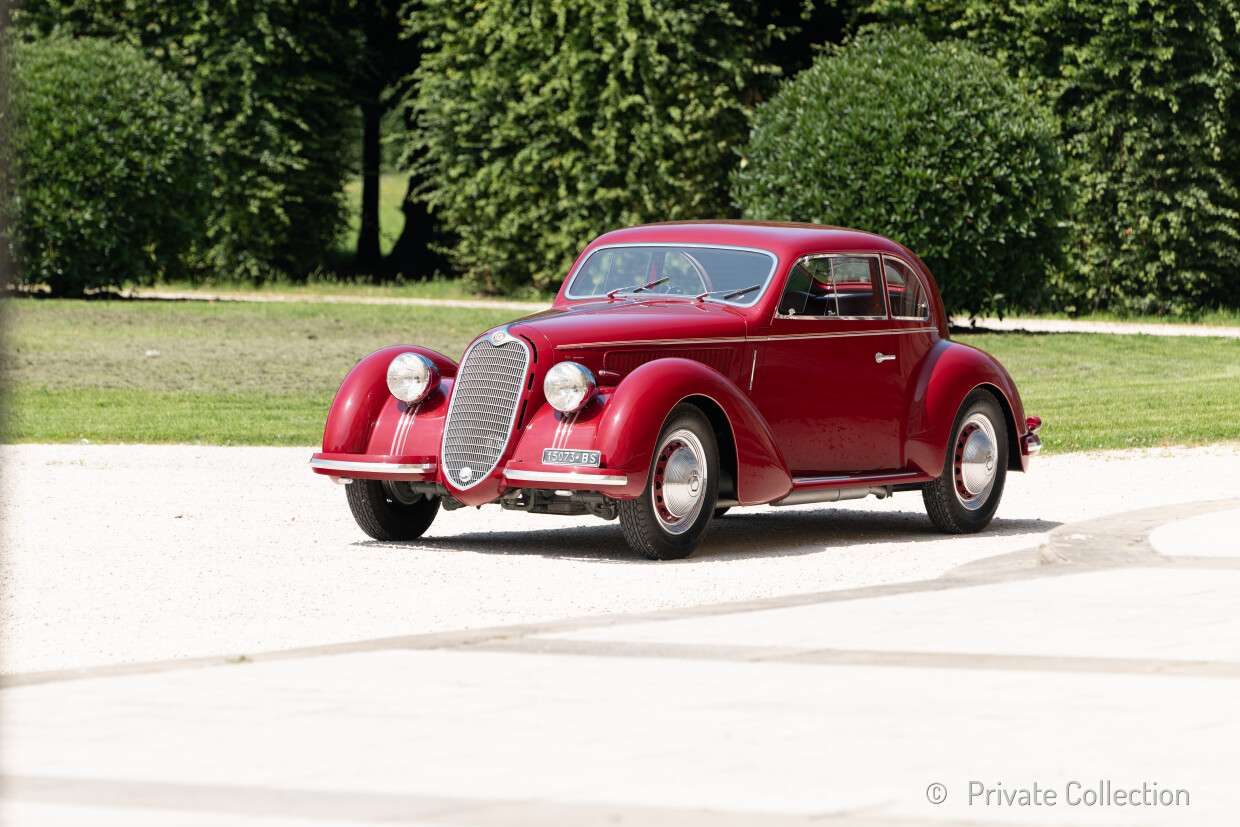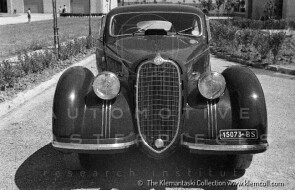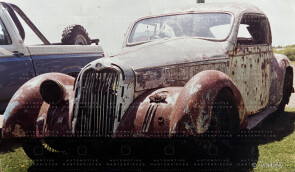
1938 Alfa Romeo 6C 2300 B Mille Miglia
ON/OFF
Why am I an Automotive Masterpiece?
L. Limited edition cars
no. 107 manufactured
The history of Alfa Romeo coincides basically with that of the history of the automobile and features many stories and numerous cars. The Alfa Romeo 6C stands out amongst the most representative models – the cars of the beginning and the modern post-war ones, and the racing and touring cars. The long journey of the Alfa Romeo 6C lasted almost 25 years, accompanying Alfa Romeo industries from the 20s to the 50s. In the early 1920s, Vittorio Jano was commissioned with creating a lightweight, high-performance vehicle to replace the large and heavy RL and RM models. Between 1927 and 1954, the Alfa Romeo 6C was produced in a series of models: road, race, and sports cars. The "6C" name refers to the number of cylinders of the car's straight six-cylinder engine. The different models’ bodyworks were made by coachbuilders such as Castagna, James Young, Pinin Farina, Touring and Zagato. From 1933, a custom-made Alfa Romeo’s built bodywork became available; it was made in Portello. The car was introduced in April 1925 at the Salone dell'Automobile di Milano as the 6C 1500. The 2-litre formula - that led Alfa Romeo to win the Automobile World Championship in 1925 - changed into the 1.5-litre formula for 1926’s races season. The production started in 1927, with the P2 Grand Prix car as a base model. The more performative 6C 1750 was introduced in 1929 in Rome. The car featured a top speed of 95 mph (153 km/h), a chassis designed to flex and bend over curved surfaces, as well as sensitive geared-up steering. It was produced in six series between 1929 and 1933. The base model had a single overhead camshaft. The Super Sport and Gran Sport versions had a double overhead camshaft (DOHC), and a compressor was available. Most of the cars were sold just as a chassis then bodied by coachbuilders. The 1750 quickly gained a reputation for winning races. In 1933, the last year of the 1750 production, the new Alfa Romeo 6C 1900 version was introduced, with a displacement of 1917 cm³ and with a light alloy head – used here for the first time. To satisfy the market’s request for a high-performance automobile sold at a lower price, Alfa Romeo introduced a new car at the Salone dell’Auto di Milano in 1934: the 6C 2300. The car was designed to replace the 6C 1750 and its derivate, the 6C 1900. Despite the many successes, the 8C 2300s remained designated for races and never appeared in the sales catalogues. The 6C 2300 debuted at the 1934 Giro Automobilistico d’Italia. However, only at the 24 Ore di Pescara, three Gran Turismo cars with bodyworks by Carrozzeria Touring won the first three places. Therefore, after the race, Alfa Romeo began to sell the model under the new name “Pescara”. The 6C 2300 was available as Turismo and Gran Turismo. The Gran Turismo version had better performances and also the reduction of the wheelbase (2920 mm). Except for the reduction in length, the chassis was identical to that of the Turismo model and was not distinguished by any particular technical innovations. Production was limited to 1934, and the chassis of all Gran Turismo versions were numbered from 700101 to 700635. A total of 1.606 specimens of 6C 2300 were produced, including bare chassis for the coachbuilders and complete cars. Alfa Romeo cars were absolute leaders in the history of the Mille Miglia race, and the various 6C models participated with actual squadrons, led by the most talented drivers of the time. The 6C 2300 participated in the Mille Miglia in four different years. Its debut was in 1935 when a specimen led by Franco Cortese earned the 8th place overall. At the 1936 Mille Miglia, three out of four participating 6C 2300s ranked 9th, 11th and 13th overall. Ercole Boratto, Mussolini's driver, drove the last one. The 6C 2300 were also the only ones registered, in that year, in the "Classe oltre 2.000 cc senza compressore" and, therefore, they were 1st, 2nd, 3rd in their class. In 1937, the 6C 2300 ran the Mille Miglia with 10 cars in their various versions. Ercole Boratto earned the best result in arriving 4th overall. In 1938, the 6C 2300 ran the Mille Miglia with 12 cars in their various versions. Franco Cortese earned the best result in arriving 9th overall.
The feature of the new 6C 2300 B was a highly sophisticated chassis. It was launched in 1935 and remained in production until 1938, and until 1939 for the Corto and Lungo models; it was then followed by the 6C 2500. It was embellished by four-wheel independent suspension, a rear swing axle and hydraulic brakes. Only the engine stayed almost identical to the preceding 6C 2300 model of the previous year, but nothing resembled the initial production. The new 6C 2300 B Mille Miglia was presented in 1937. The first Berlinetta Touring with Superleggera bodywork is chassis 813821 which ran the 1937 Mille Miglia with race number 119, placing 4th overall with Boratto-Guidotti: Alfa Romeo 6C 2300 MM Berlinetta touring Scuderia Ferrari. With a line aimed at aerodynamics, this berlinetta is to be considered a milestone in the history of Carrozzeria Touring, it is in fact the first "Superleggera" built; Touring patented the Superleggera design using ultralight alloys and components with aluminum panels over a cage-like steel frame: lightness is guaranteed, with a 6C body weight of only 126 kg. From now on, the Pescara berlinettas became the Mille Miglia with the new Superleggera bodywork. According to the registers, the Berlinetta Mille Miglia bodywork could also be fitted to chassis no. 813913, 813914, 813915, 813821, 813851. The 1937 cars would therefore be a few number of pre-series (or 1st series) Mille Miglia Berlinettas. The “regular” 6C 2300 B Mille Miglia (2nd series) was only produced in 1938, the numbering resuming in the range of chassis 815001 and 815101. The main difference is in the cockpit roof, higher in the 1st series and which will be lowered in the 2nd. It was the last of the series of 2300 B, based on the chassis of the 6C 2300 Pescara, with a 10 hp power increase, reaching the maximum speed of 170 kph.
The Alfa Romeo 6C 2300 B Mille Miglia, chassis no. 815074 and engine no. 824029, is from the lot of 101 units (chassis from 815001 to 815101) of the second series manufactured in 1938; it is almost 3/4 into the chronological order of production, coachbuilt as a Berlinetta with the Superleggera system by Carrozzeria Touring, in a 4-seater configuration intended for Gran Turismo use. Assembly of the vehicle was completed September 24, 1938. The Berlinetta Touring, due to their artisanal production, differed in small details; chassis no. 815074 was fitted with wire wheels covered by large, chromed brass hubcaps, with slots for brakes’ cooling, anticipating those of the 6C 2500 models. Noteworthy is the rare three parallel chrome platings on the front fenders, anticipating the ones of to the 6C 2500 SS "Ala Spessa", where the platings originated from the headlight while, in this case, the platings run between the bumper and the headlights. Only three cars with this feature are known: this chassis, chassis no. 815084 and a third unknown chassis one. Chassis no. 815074 was ordered new by Franco Mazzotti who paid 78,500 lire for it. The car, finished in red, was registered in Brescia on December 2, 1938, with plate BS 15073. Count Franco Mazzotti Biancinelli Faglia might be considered the model’s “archetypal” owner: a racing driver, aviator and aristocrat. He is mostly known for having been one of the four "musketeers", along with Aymo Maggi, Renzo Castagneto and Giovanni Canestrini, who founded the Mille Miglia race; Mazzotti provided financial support and was the author of the Mille Miglia name. Chassis no. 815074 featured a unique detail that we find in other cars belonging to the count: the Touring logo on the bonnet wings is replaced with the red arrow of the Mille Miglia. There is also a special Alfa Romeo badge from that period, and pinstriping on both sides. 1938 was a difficult year for personal story of Franco Mazzotti and for many other reasons, and this influenced the early history of the car and its sporting use. Mazzotti was a public figure, yet there are no photos of him with this car. A possible reason was public opinion's reaction to the accident occurred at the 1938 Mille Miglia, which recommended a more understated appearance. October 14, 1939, Mazzotti returned chassis no. 815074 to Alfa Romeo, purchasing an 8C. The new plate assigned to the car was MI 73396. On February 26, 1940, Alfa Romeo sold the car to Count Niccolò di Lana, well-known Piaggio aircraft test pilot. The car received plate SV 5912. The car is finally photographed for the first time in June 1940 by Corrado Millanta; the setting is an airground in front of some hangars, the car is still wearing its Brescia plates. With the arrival of the war time, any competitive ambitions for the car finally set. Lana managed to save it from such cars’ typical fate during the war: to be damaged or requisitioned. He sells the car on 12 December 12, 1946, to Fernando Zarattini, owner of a FIAT dealership in Rome and so the car receives a new plate: ROMA 96948. He sells the car on June 26, 1951, to Fernando from the Venturi family, owner of the Rome Alfa Romeo dealership as well as a boat building company. Fernando, with his brother Franco, were renowned collectors of important cars as well as gentleman drivers. But the story of the chassis no. 815074 takes an unexpected turn: in the 1960s the car was exported to Argentina, where it had a rather checkered history: in the following years it was used to carry drugs between Argentina and Uruguay; in order to run easier on dirt (hidden) roads, the car was modified, by cutting off the lower part of the front. This until it was seized by police and, as often happens, remains neglected in storage for years. The rumor spread and in December 1987, Carlos Enrique Gatto made an agreement with the Police Department and received the Alfa Romeo chassis no. 815974 (according to papers, but this is a typo and should read 815074), missing the engine, seats, and accessories. In January 1988, he sold the car to Franco Monnanni who had an agreement with Noel Girelli to buy, restore, and sell cars. In March, Girelli imported the car from Uruguay to Argentina and started disassembling it. But the relationship between Girelli and Monnanni became tense, since the last one wanted to keep the car, but Girelli asked for it a lot more money. In the end, Girelli took the car hiding it in a nearby garage. Monnanni looked for and finally found the car, reporting it as stolen and found to the police: this started a lawsuit. It is not clear how Girelli ended up with the car, but he restored it and sold it to the Italian industrialist Libero “Toti” Brielli who undertook the restoration of the car; but, while the effort must be recognized, the result was not entirely faithful. In May 1992, the car returns to Italy. Finally, the time has come to express its true sporting nature, participating in classic car races. From 1992 to 2000 (except 1995) chassis no. 815074 is at the Mille Miglia re-enactments. In 2006, the car becomes property of Pietro Rotundo, who sells it on November 21, 2018, to a private collector. In 2023 the car is subjected to a new and thorough restoration. The work carried out is faithful to the history of the car, meticulous and of the highest quality. Recognizing the value of the car as a work of art, it was possible to use, during the painting process for the restoration, a special nitro-based paint, recreated in small quantities for these cases, which faithfully reproduces the finish, tone, texture, and reflections of the original Cherry Red paint, accompanied by dark red interiors in a leather that is absolutely compliant with the original. A dedicated Monographic Chassis Book on the car will be published by Automotive Masterpieces. Its researches are RINA certified.




